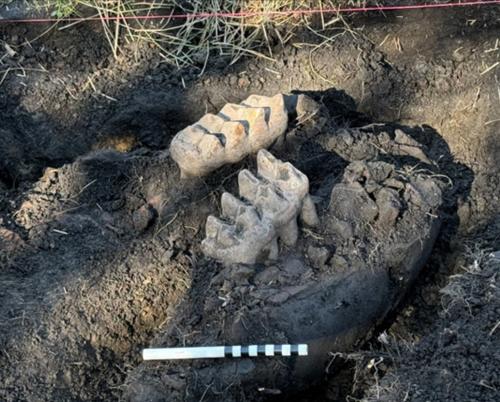Scientists pinpoint exactly when dogs became man's best friend
Share:
Humans domesticated dogs thousands of years earlier than initially thought, according to new research. Analyses of canine bones in Alaska suggests man and dog were living together much earlier than previously thought - around 10,000 BC. The bones contained traces of salmon proteins, indicating that canines were regularly eating fish that must have been caught by humans - a sign of domestication.
![[Pictured above, the dig site known as 'Hollembaek Hill,' south of Delta Junction in Alaska where the ancient canine jawbone was unearthed. Archaeologists have long done research in partnership with local tribes in this Delta Junction area]](https://i.dailymail.co.uk/1s/2024/12/04/20/92799605-14158157-Pictured_above_the_dig_site_known_as_Hollembaek_Hill_south_of_De-a-2_1733343508886.jpg)
Researchers from the the University of Arizona found a 12,000-year-old lower leg bone that belonged to a wolf-sized, adult canine at an archaeological site called Swan Point, located about 70 miles southeast of Fairbanks. Swan Point is one of several sites in the area that contain some of the oldest evidence of human habitation in the state.
![[The jawbone and this leg bone found at Swan Point, Alaska (seen above in a composite scan) both showed chemical evidence of salmon proteins in lab tests - a discovery that led the team to conclude ancient humans had likely fed the fish to the canines, who did not hunt fish in the wild]](https://i.dailymail.co.uk/1s/2024/12/04/19/92799603-14158157-The_jawbone_and_this_leg_bone_found_at_Swan_Point_Alaska_seen_ab-a-36_1733341998695.jpg)
This ancient dog had been alive near the end of the Ice Age, suggesting that Indigenous Alaskans formed relationships with dogs some 2,000 years earlier than previous studies had shown. The researchers believe this recovered leg bone helps establish the earliest known close relationships between humans and canines in the Americas.
![[Above, an image of François Lanoë, an assistant research professor in the University of Arizona School of Anthropology, after helping unearth the 8,100-year-old canine jawbone in June 2023]](https://i.dailymail.co.uk/1s/2024/12/04/18/92799599-14158157-image-a-50_1733338776125.jpg)
In addition, the team found an 8,100-year-old canine jawbone at the nearby Hollembaek Hill dig site south of Delta Junction, providing evidence of domesticated dogs' continued presence in human settlements. Researchers unearthed this 8,100-year-old canine jawbone (above) in interior Alaska in June 2023. The bone is among the earliest evidence that ancestors of today's dogs formed close relationships with people in the Americas roughly 2,000 years earlier than previously thought.
![[The researcher noted that this evidence - while compelling indicators of when dogs were first domesticated - is still a long way off from a solid official timeline. Above an illustration of an early American travelling with their canine companion]](https://i.dailymail.co.uk/1s/2024/12/04/19/92800177-14158157-The_researcher_noted_that_this_evidence_while_compelling_indicat-a-35_1733341998689.jpg)






















